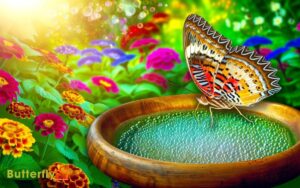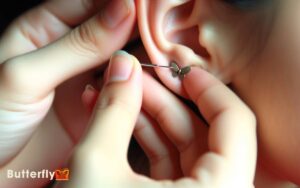Do Deer Eat Butterfly Bushes? Unveiling the Facts!
You might worry about deer munching on your butterfly bushes, but there’s good news. These plants exhibit moderate deer resistance due to iridoid glycosides, which are natural deterrents.
However, in areas with significant deer populations, protective measures like fencing can offer extra security. For more insights into maintaining a deer-resistant garden, keep exploring our advice.

Key Takeaways
Deer Feeding Habits
Deer exhibit diverse feeding habits that are influenced by seasonal availability, nutritional needs, and habitat conditions.
You’ll find that during spring and summer, deer primarily consume nutrient-rich forbs and grasses. These plants provide essential proteins and minerals important for growth and reproduction.
Come autumn, their diet shifts towards mast like acorns and other nuts, offering high-energy reserves essential for winter survival.
In harsh winters, deer often browse on woody vegetation, such as twigs and bark, as other food sources become scarce. This adaptability allows deer to thrive in diverse environments.
Studies have shown that habitat quality greatly impacts dietary choices, with deer preferring areas rich in preferred forage species. Understanding these habits is key to managing deer populations effectively.
Butterfly Bush Characteristics
When considering Butterfly Bush characteristics, you’ll find that they bloom in various vibrant colors from summer to fall.
They exhibit rapid growth, often reaching heights between 6 to 12 feet.
These hardy shrubs thrive in well-drained soil and full sunlight, making them adaptable to a range of garden environments.
Flowering Seasons and Colors
Butterfly bushes, known for their vibrant and diverse colors, typically bloom from mid-summer to early fall, providing an essential nectar source for pollinators during that period.
You’ll observe a spectrum of hues, including deep purples, bright pinks, and pure whites. These chromatic variations result from anthocyanin pigments, which are influenced by genetics and environmental factors such as soil pH and light exposure.
The inflorescences, composed of numerous small tubular flowers, are particularly appealing to butterflies, bees, and hummingbirds. Research indicates that the prolonged blooming period aligns with the peak activity of these pollinators, thereby maximizing ecological benefits.
Understanding these flowering patterns can help you optimize your garden for both aesthetic appeal and ecological function.
Growth Habits and Size
Understanding the growth habits and size of Buddleja davidii, commonly known as butterfly bush, is crucial to optimizing its placement and care in your garden. This deciduous shrub typically reaches heights of 6 to 12 feet, with a spread of 4 to 15 feet.
Its rapid growth rate allows it to establish quickly, often growing several feet in a single season.
The butterfly bush exhibits an arching habit, producing long, slender branches that can become somewhat woody with age. Pruning is beneficial to maintain its shape and promote vigorous flowering.
Additionally, its ability to regenerate from old wood makes it a resilient addition to diverse garden settings. Proper spacing guarantees adequate air circulation, reducing susceptibility to diseases.
Soil and Sunlight Needs
To thrive, Buddleja davidii requires well-drained soil and full sun exposure, ensuring ideal growth and prolific blooming. You should plant it in a location receiving at least six hours of sunlight daily.
This species prefers slightly acidic to neutral pH levels, ranging from 6.0 to 7.5. Adequate soil drainage prevents root rot, a common issue in waterlogged conditions.
Here’s a summary of the ideal conditions:
| Soil Type | pH Range | Sunlight Hours |
|---|---|---|
| Well-drained | 6.0-7.5 | 6+ |
| Loamy or Sandy | Neutral | Full Sun |
| Avoid Clay Soils | Slightly Acidic | Maximum |
Deer Resistance of Butterfly Bushes
In recent studies, researchers have found that butterfly bushes exhibit a moderate level of deer resistance due to their mildly toxic compounds and unpalatable foliage. These factors deter deer from frequent consumption. Additionally, this resistance makes butterfly bushes a favorable choice for gardeners looking to minimize wildlife damage. However, while deer tend to avoid them, smaller herbivores may still occasionally feed on the plants. For example, some gardeners may wonder, do rabbits eat butterfly weed, as other small mammals sometimes nibble on similar foliage.
The presence of iridoid glycosides in the leaves contributes to the plant’s bitterness and toxicity, making it less appealing to deer. Additionally, the rough texture and strong scent of the foliage act as further deterrents.
While not entirely deer-proof, butterfly bushes are less likely to be severely damaged compared to other more palatable plants. Understanding these mechanisms can help you make informed decisions when planning a deer-resistant garden.
Despite varying deer populations and behavior, butterfly bushes generally fare well in areas with moderate deer pressure.
Evidence From Gardeners
Gardeners across various regions have reported that butterfly bushes generally remain intact despite the presence of deer, corroborating scientific findings about the plant’s moderate resistance.
You’ll find anecdotal evidence from numerous gardeners who observed that deer tend to bypass butterfly bushes in favor of more palatable vegetation. Reports consistently indicate that, while minor nibbling might occur, significant damage is rare.
This aligns with research suggesting that butterfly bushes contain compounds that are less attractive to deer. Additionally, gardeners note that the plant’s robust growth habit and rapid recovery further mitigate any minor deer interference.
Such empirical evidence from diverse gardening environments underpins the plant’s reputation as a relatively deer-resistant option for your landscape.
Protecting Your Butterfly Bushes
To protect your butterfly bushes from deer, consider installing physical barriers such as fencing, which studies show can effectively deter deer intrusion.
Additionally, integrating deer-repellent plants around your butterfly bushes creates a natural deterrent, supported by research indicating these plants can reduce deer browsing.
Employing these strategies not only safeguards your plants but also promotes a balanced garden ecosystem.
Fencing and Barriers
Installing a sturdy fence around your butterfly bushes effectively deters deer, providing a reliable physical barrier against unwanted grazing.
Research indicates that fences should be at least 8 feet tall, as deer are capable of jumping over lower barriers. Additionally, opting for wire mesh or electric fencing enhances efficacy.
Empirical studies suggest that a double-layered fence, spaced a few feet apart, disorients deer and reduces their ability to leap over.
Regular maintenance, such as checking for gaps and ensuring the fence’s integrity, is essential. While fencing incurs initial costs, it offers a long-term solution.
Integrating motion-activated lights or sprinklers can further deter deer, leveraging their aversion to sudden stimuli, thus protecting your butterfly bushes comprehensively.
Deer-Repellent Plants
Incorporating deer-repellent plants into your garden can serve as an effective strategy to protect butterfly bushes by exploiting deer’s natural aversions.
Plants like lavender (Lavandula), yarrow (Achillea millefolium), and Russian sage (Perovskia atriplicifolia) produce aromatic compounds that deer find unappealing. Empirical studies indicate that deer tend to avoid areas where these plants are abundant.
Additionally, integrating thorny or prickly species such as barberry (Berberis) can create a physical deterrent. By strategically placing these repellent plants around your butterfly bushes, you create a multi-layered defense mechanism.
This approach leverages both olfactory and tactile deterrents to minimize the risk of deer damage. Remember, combining plant selection with other strategies enhances overall effectiveness.
Alternative Deer-Resistant Plants
Many gardeners opt for deer-resistant plants like lavender, yarrow, and Russian sage, which deter deer due to their strong scents and bitter flavors. These plants possess secondary metabolites such as terpenes and alkaloids, which are unpalatable to deer.
- Lavender (Lavandula spp.) contains linalool, a compound known for its aromatic and deterrent properties.
- Yarrow (Achillea millefolium), rich in sesquiterpene lactones, offers both visual appeal and resistance.
- Russian sage (Perovskia atriplicifolia) produces camphoraceous oils, making it less attractive to herbivores.
Incorporating these species into your garden not only minimizes deer intrusion but also supports biodiversity. By understanding the chemical deterrents in these plants, you can make informed choices to create a more resilient garden ecosystem.
Conclusion
To sum up, butterfly bushes are generally deer-resistant, but not entirely immune.
Imagine you’re a gardener in a suburban area one night, you notice deer tracks near your butterfly bushes, but the plants remain untouched.
This real-world observation supports evidence showing that while deer may occasionally nibble, they usually prefer other foliage.
By understanding deer feeding habits and selecting alternative deer-resistant plants, you can effectively protect your butterfly bushes and maintain a thriving garden.






I don’t think the title of your article matches the content lol. Just kidding, mainly because I had some doubts after reading the article.
Your point of view caught my eye and was very interesting. Thanks. I have a question for you.
Can you be more specific about the content of your article? After reading it, I still have some doubts. Hope you can help me. https://accounts.binance.com/uk-UA/register-person?ref=W0BCQMF1
Your point of view caught my eye and was very interesting. Thanks. I have a question for you.
Your point of view caught my eye and was very interesting. Thanks. I have a question for you.
Thanks for sharing. I read many of your blog posts, cool, your blog is very good.
Thanks for sharing. I read many of your blog posts, cool, your blog is very good.
Thanks for sharing. I read many of your blog posts, cool, your blog is very good.
For these seeking to optimize their fitness performance, the
conversation usually turns to anabolic steroids. This complete information delves into the most effective ways to utilize these substances, highlighting
their benefits, risks, and most secure practices for novices.
As you explore the world of steroids, it’s crucial to grasp the
significant impression they’ll have on your physique and overall health.
By harnessing the power of these hormones, particularly testosterone, you
can obtain exceptional features in muscle mass and
strength. The potential side effects of those substances are well-documented, ranging from hormonal imbalances to critical medical problems.
Sleep is crucial for hormone production and managing temper swings, widespread
during PCT. Sufficient sleep, constant sleep schedules,
and a snug sleep surroundings are recommended.
PCT’s period typically ranges from one month to a number of weeks, depending
on particular person circumstances and supplement
sort. Throughout PCT, it’s suggested to proceed coaching but with decreased depth, emphasizing relaxation, recovery, and balanced nutrition. In rare cases, Anavar utilization may set off a serious allergic reaction that
demands immediate medical help.
There is zero level in taking two SARMs with the identical
or comparable mechanism of action; you could as nicely take
a better dose of 1 SARM. Synergy includes combining SARMs that
take a special path to deliver results with decreased
unwanted side effects. So manufacturing labs then have to resolve how they’ll ship that SARM powder
to you, the buyer. They can put the powder right into a capsule,
but because SARMs are not legally allowed to be offered for human consumption, this methodology indirectly implies that the SARM is made for individuals to use.
I will first listing the “efficiency enhancing medicine” and the go
into higher element. You’ll want 20 tabs of Clomid right here,
and you should start your Clomid 14 days after your last shot IN ANY three OF THESE CYCLES.
Girls who use Primo at doses low sufficient to avoid virilization will discover that achieving a dry and outlined
physique is the cornerstone of a Primo cycle. This can take a while to develop, and
women should be willing to wait round 5 weeks to begin out seeing noticeable
physique advantages. Working a 10-week cycle is an inexpensive objective for females, with doses
as a lot as 50mg per week.
Joint and bone support could be why some folks add Deca to an extended cycle as
a secondary compound. Unfavorable libido impacts are
possible; dosage is usually set at half of the testosterone dose to combat
this. Deca and EQ combine very properly with testosterone, and their estrogenic and androgenic
effects are much less extreme.
It has already been established that a really first cycle consisting of Testosterone-only
is one of the best and most secure choice for a newbie.
With this being said, the most acceptable choices of compounds will be covered right here.
The most typical side impact is liver damage, so it’s
essential to restrict your dosage and cycle length.
Just make sure to follow the recommended
dosage and cycle size to keep away from any negative side
effects. Simply remember to monitor your progress fastidiously
and hearken to your physique, should you start experiencing
any negative side effects, it’s time to cease using the drug.
Opposite to in style perception, women can and do use injectable Primo simply as
typically as oral. Females using Primobolan Depot can purpose
for a 50mg/week starting dose, and when you respond nicely, rising it to
100mg/week is in all probability going all you’ll
ever need. Very low doses of Primo won’t have you gaining much or any mass in any respect, but that’s not likely to be your objective if you’re starting at
a low dose. 250mg/week can add some vascularity and
provide a delicate introduction to Primobolan. Primobolan has exceptional benefits
for both the cutting and lean bulking consumer. It’s not an AAS we’ll ever use for fast, huge
positive aspects, however one that can provide noticeable physique enhancement over a more extended interval.
These simple steps help new users of steroids have a safer and better time.
The thought behind a cycle is that the body will expertise
highly effective muscle and strength features in the course of the “on” interval and, with a well-managed post-cycle section,
keep away from or manage a variety of the
negative results. Throughout these cycles, testosterone helps to take care of
muscle-building properties while also countering some unwanted effects
of trenbolone, similar to reducing natural testosterone
production. Intermediate bodybuilders typically have a better understanding of how their body responds to completely different cycles and dosages.
By this stage, they may begin to fine-tune their Anavar usage, similar to stacking
with different dietary supplements or anabolic steroids, to optimize results additional.
Consistently monitoring progress and adjusting dosages and cycles accordingly
will help in constructing lean muscle mass whereas maintaining side effects underneath management.
Tren is another one of many Greatest Injectable Cycles that’s extremely beneficial for newbies.
This injectable is most acceptable for bodybuilders who begin with
a giant body and wish to get massive in a quantity of weeks.
In 2017, the US FDA issued a warning about SARMs and acknowledged that they may improve the chance
of heart assault and stroke31. For instance, Andarine, when used
at larger doses, can deliver a few yellow tinge to the
imaginative and prescient in some people. You can minimize this threat by maintaining your Andarine dose
beneath 50mg day by day. Gentle sensitivity is one other potential aspect impact
of Andarine, but it isn’t recognized what causes this, and it’ll often disappear once you cease utilizing the SARM.
Most of the regularly talked-about SARM side effects concern their use by men, and this revolves across the discount in testosterone levels that a few of the extra highly effective SARMs trigger.
Monitoring and managing potential unwanted effects is an integral aspect of
a responsible steroid cycle. Common well being
check-ups, alongside attentive self-assessment, might help identify any opposed reactions early on, permitting for well timed adjustments or
interventions. Keep In Mind that the objective is not just speedy aesthetic features
but sustainable progress that contributes to your long-term well-being.
Moreover, Teamroids’ competitive pricing mannequin makes the acquisition of anabolic
steroids extra accessible to a broader audience.
The affordability of their merchandise caters to people
from varied financial backgrounds, promoting inclusivity throughout the bodybuilding community.
It is considered one of the reasons the steroid is extensively used for
medicinal purposes. With deca, you don’t have to
worry about interference with liver function and cardiovascular health.
Nevertheless, should you experience antagonistic side effects, then it means deca may
have been stacked with other poisonous steroids. In abstract, when on the journey to
discover the best authorized steroids for novices, it’s essential to
be cautious and informed. Based Mostly on the info, we now have give you a listing of
the highest 5 legal steroids really helpful for beginners so as to allow you
to discover the perfect slicing or bulking steroid for your first
cycle. Some anaboilc steroids concentrate on the growth of energy and
muscle mass.
References:
Jbhnews